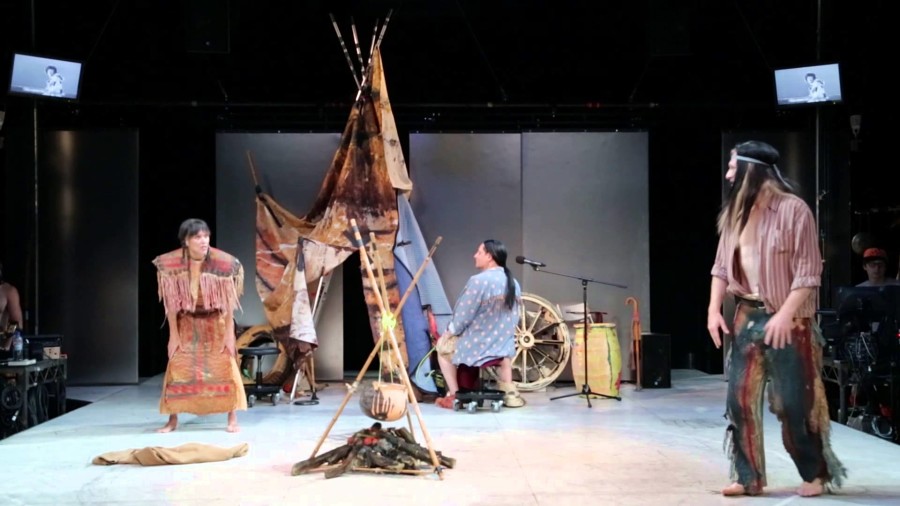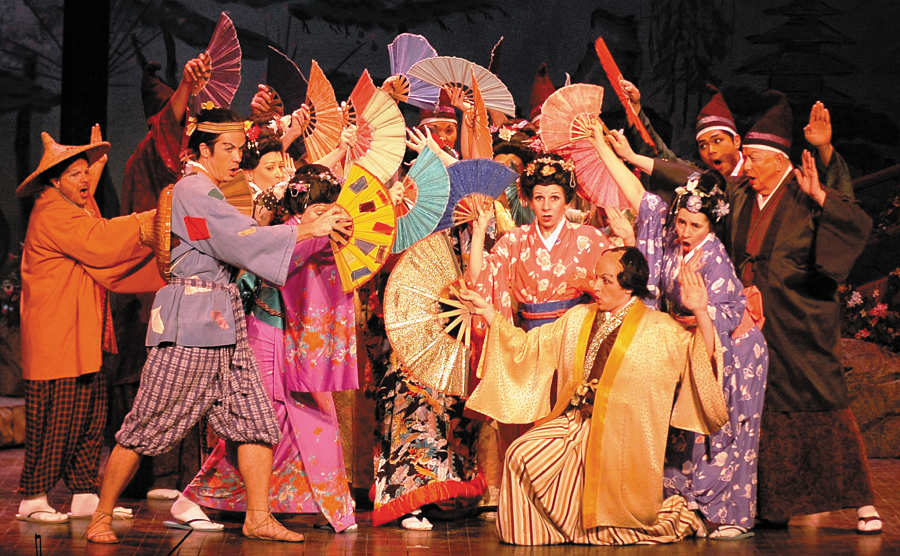On Wednesday, American Theatre announced that Muslim-American playwright Ayad Akhtar made our Top 10 Most-Produced Play list and Top 20 Most-Produced Playwrights list, becoming only the third playwright of color to occupy the top spot. That same day, a 14-year-old Muslim American boy living in Texas was arrested for bringing a homemade clock to school, because, as he’s brown and named Ahmed Mohamed, teachers and police assumed it must be a bomb. In a state where anyone can openly carry a gun, he was put in handcuffs.
This is the social climate we are living under in today’s America. For every three steps of racial progress, we take two steps back.
This same week, on Monday, the New York Gilbert & Sullivan Players announced they would mount a production of The Mikado at the NYU Skirball Center next January with an almost all-white cast, using Japanese backdrops, props, clothing, and wigs. Following playwright Leah Nanako Winkler’s perceptive blog post about the show, the hashtag #saynotoMikado was created. It was only last year that Seattle’s Gilbert & Sullivan Society came under fire for doing the exact same thing. (NYGASP announced today that, in the face of the public outcry, it is replacing its production of The Mikado with The Pirates of Penzance.)
Earlier this year, I was sitting in St. Ann’s Warehouse for the Wooster Group’s Cry, Trojans! (a take on Troilus and Cressida), in which Scott Shepherd and the rest of the predominantly white cast were dressed up in headdresses and fringed pleather pants, hollering around a campfire, with a tepee in the background. Generic Native American kitsch that you might find in a Party City. There was not one Native American actor in the cast.

The message is clear: On some American stages, as in much of our society, people of color and their cultures are still nothing more than exotic backdrops for white people to paint their neuroses on. It’s been going on for a long time: Just as The Mikado used the exotic East to make a statement about Victorian English prudery, Cry, Trojans! used Native Americans as stand-ins for the Trojans and the Greeks.
Everyone knows by now that blackface, yellowface, redface, and brownface are big no-no’s. Don’t they? But even if the artists putting on these productions know that, they seem to miss the point of why. A statement from NYGASP, released to Playbill.com (before the decision to cancel The Mikado outright) read: “It was determined that the practice of yellowface makeup—using makeup to appear Asian—was the most offensive practice brought to light by the Asian-American community. As part of a policy that is generally outlined by the statement on the website, we agreed to instruct the cast to avoid this practice specifically. Makeup that was appropriate for the stage without the manipulation of features or complexion. We also agreed to go ahead with the wigs and costumes of our traditional production.”
But yellowface/blackface/redface isn’t just about the makeup. Jonathan Pryce didn’t need to color his face brown in Miss Saigon to be complicit in yellowface. Appropriation goes beyond facepaint. It’s about the subsuming of a minority ethnic group to support the narrative of a dominant ethnic group. In their other operettas, Gilbert and Sullivan often made fun of British culture; but in The Mikado, they happened to use kimonos and a madeup land called Titipu to do it. To librettist W.S. Gilbert—whose experience of Japan was limited to repeat visits to the Japanese Village in Knightsbridge, and a bit of well-meaning consultation with its residents—the Orient was little more than a metaphor for Victorian mores, and the distance probably allowed them to go further with their satire of those mores. (I use the term Orient advisedly, since no representation of Japan or China or India in that time could really be called Asian; it was the Orient—Asia as seen through a scrim of Western fantasy.)
Looking at the audience during Cry, Trojans!, which was met with protests from the Native American artist community during its run in Los Angeles and New York City, I saw no faces of color other than my own. Elizabeth LeCompte, as reported in LA Observed, said that Cry, Trojans! did not employ any Native American actors because that would have been tokenism, adding, “It’s not about that. It’s about everything bigger…We love the piece, we love the stories, we love the films, we love the people…We wanted to tell the story in this way and make it so big that this [lack of direct Native American input] wouldn’t be a problem.”
Appropriation is not just outright stealing. It is relegating any trace of non-white ethnicity to set dressing, while not employing people of color as performers or on your creative team. It’s putting white actors in kimonos or leather dresses so that white artists can have a conversation about white culture with white audiences. It’s frolicking in a fantasy place and pretending the people who live in the actual place don’t exist.
Ethnic minorities are poised to overtake the percentage of non-Hispanic whites in the U.S. by 2042. People of color are no longer a metaphor. We are living, real people yearning for representation. The message sent to people of color by productions like an unreconstructed yellowface staging of The Mikado or Cry, Trojans! is basically: “You are not important enough to be respected. You don’t deserve a voice onstage. You are nothing but objects to us.”
So, in case the message isn’t clear, to any group who wants to put white actors in ethnic makeup and regalia: Just stop. You are doing something racist. If you want to pay homage to another culture, cast actors of that culture in the lead roles, hire a playwright from that culture to write (or at least adapt!) that play, bring a director of that same background into the room. Do any or all of the above (or, if you want to recontextualize a work like The Mikado, there are plenty of fine examples how to do that here, here, and here).
Stop wearing our clothes. Stop painting your faces. Stop pretending we don’t exist.


